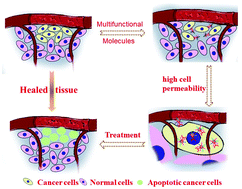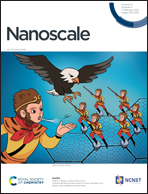Novel multifunctional nano-hybrid polyhedral oligomeric silsesquioxane-based molecules with high cell permeability: molecular design and application for diagnosis and treatment of tumors†
Abstract
Chemotherapy mostly functions as a carrier for direct drug delivery to the tumor, which may induce secondary damage to healthy tissue cells around the tumor. To avoid this side effect, using multifunctional drugs with high cell permeability during chemotherapy is crucial to achieve significant antitumor efficacy. In this study, polyhedral oligomeric silsesquioxane-based multifunctional organic–inorganic hybrid molecules with potential for recognition, imaging, and treatment were designed and successfully synthesized through a facile and efficient one-pot reaction process. The structure and properties of the synthesized multifunctional molecules were characterized by Fourier transform infrared spectroscopy, nuclear magnetic resonance spectroscopy, mass spectrometry, fluorescence spectroscopy, cytotoxicity assay, surface tension testing, cell compatibility testing, hematoxylin and eosin staining, as well as in vivo and in vitro studies. The results demonstrated that these multifunctional molecules can be effectively used for delivering precisely-targeted imaging and therapeutic agents and exhibited considerable cell permeability. The excellent synergy between high permeability and precise targeting results in multifunctional molecules with superior diagnostic performance.



 Please wait while we load your content...
Please wait while we load your content...